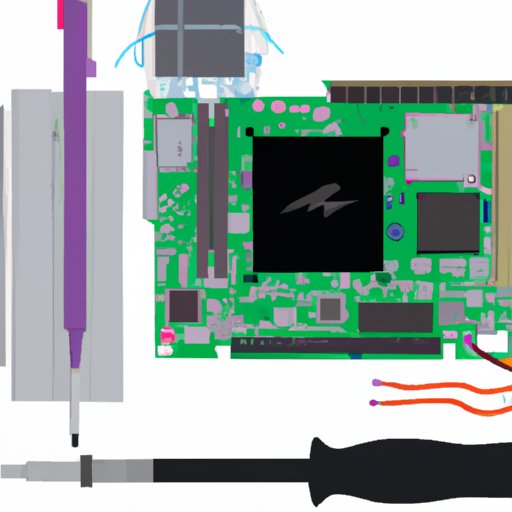Introduction
A technological tool is an instrument or device that helps to facilitate tasks or activities by leveraging technology. These tools are used to improve efficiency and productivity in businesses, organizations, and even homes. They range from simple handheld devices to complex computer systems, and they can be used for many different purposes.
Definition of Technological Tool
A technological tool is defined as any device or system that uses technology to improve the performance of a task or activity. This includes computers, smartphones, tablets, printers, scanners, and other digital tools. It also includes physical tools such as robots, automated machines, and 3D printers.
Purpose of Using Technological Tools
The purpose of using technological tools is to increase efficiency, productivity, and accuracy. By leveraging technology, tasks can be completed faster and with fewer errors. This can help to reduce costs and improve customer service. Additionally, technological tools can enable businesses to do more with less and stay ahead of their competition.

Overview of Different Types of Technological Tools
There are many different types of technological tools available, each designed to meet specific needs. Here is a brief overview of some of the most common types:
Hardware Tools
Hardware tools are physical devices that are used to perform tasks. This includes laptops, desktop computers, tablets, smartphones, printers, scanners, and more. Hardware tools are typically used for computing, communications, data storage, and printing.
Software Tools
Software tools are computer programs that are used to accomplish specific tasks. This includes operating systems, web browsers, office suites, photo editing software, and more. Software tools are typically used for computing, communications, data analysis, and document creation.
Networking Tools
Networking tools are used to connect computers and other devices. This includes routers, switches, modems, and wireless access points. Networking tools are typically used for communication, data sharing, and remote access.
Data Storage Tools
Data storage tools are used to store and access data. This includes hard drives, optical drives, flash drives, and cloud storage. Data storage tools are typically used for storing and accessing files, documents, images, and videos.
How to Choose the Right Technological Tool for Your Needs
When choosing the right technological tool for your needs, there are several factors to consider. Here are some tips to help you make the best decision:
Identifying Your Needs
The first step is to identify your needs. What tasks do you need to accomplish? What type of data do you need to store? What kind of performance do you need? Answering these questions will help you determine which type of tool is best for your needs.
Evaluating the Different Options
Once you have identified your needs, you can begin to evaluate the different options. Compare the features, performance, and cost of the various tools. Read reviews and talk to experts to get their opinion. Take your time to make sure you choose the right tool.
Taking Cost into Consideration
Cost is always an important factor when choosing a technological tool. While it may be tempting to go with the cheapest option, make sure you consider the long-term costs. In some cases, investing in a higher quality tool may be worth the additional cost.

Benefits of Utilizing Technological Tools
Using technological tools can provide numerous benefits for businesses, organizations, and individuals. Here are some of the advantages of utilizing these tools:
Increased Productivity
Technological tools can help to increase productivity by enabling tasks to be completed faster and more accurately. According to a study by McKinsey & Company, “the use of digital technologies can increase labor productivity by up to 50 percent.”
Improved Efficiency
Technological tools can also help to improve efficiency. By automating tasks and reducing manual processes, tasks can be done faster and more accurately. This can lead to quicker turnaround times and improved customer satisfaction.
Enhanced Security
Finally, technological tools can help to enhance security. By leveraging encryption and authentication protocols, data can be protected from unauthorized access. This can help to protect sensitive information and keep businesses compliant with industry regulations.
Exploring the Latest Technological Tools on the Market
Now that we’ve explored the basics of technological tools, let’s take a look at some of the latest tools on the market. Here are three of the hottest trends in technology:
Virtual Reality
Virtual reality (VR) is a computer-generated simulation of a 3D environment. VR headsets are used to immerse users in a virtual world, allowing them to interact with objects and explore new environments. VR is becoming increasingly popular in the gaming industry, but it is also being used for training, education, and even therapy.
Artificial Intelligence
Artificial intelligence (AI) is the ability of a computer to imitate human behavior. AI is used to automate processes, analyze data, and provide real-time insights. AI is becoming increasingly prevalent in many industries, from healthcare to finance, and it is revolutionizing the way businesses operate.
Robotics
Robotics is the use of automated machines to complete tasks. Robots are being used for manufacturing, logistics, and even healthcare. Robotics is providing businesses with increased efficiency, accuracy, and safety, while also reducing costs.

A Guide to Integrating Technological Tools into Your Business
Integrating technological tools into your business can be a daunting task. Here are some tips to help make the process easier:
Establishing Goals
The first step is to establish your goals. What do you hope to achieve by incorporating these tools? Do you want to increase efficiency? Reduce costs? Improve customer service? Knowing your goals will help you to choose the right tools.
Choosing the Right Tools
Once you have established your goals, it’s time to choose the right tools. Consider the types of tools you need, the performance you require, and the cost. Make sure you research each option before making a decision.
Training Staff
Once you have chosen the right tools, you need to train your staff. Make sure everyone understands how to use the tools and how they can be used to achieve your goals. Investing in training will ensure that your employees are comfortable and confident with the new technology.
Developing a Plan of Action
Finally, you need to develop a plan of action. This should include a timeline, a budget, and a list of responsibilities. Having a plan in place will help to ensure that the integration process goes smoothly.
Conclusion
In conclusion, technological tools are essential for businesses to stay competitive and efficient. There are many different types of tools available, from hardware to software to networking. Choosing the right tool for your needs is key to achieving success. Additionally, utilizing these tools can provide numerous benefits, such as increased productivity and enhanced security. Finally, following a plan of action will help to ensure that the integration process goes smoothly.
(Note: Is this article not meeting your expectations? Do you have knowledge or insights to share? Unlock new opportunities and expand your reach by joining our authors team. Click Registration to join us and share your expertise with our readers.)
